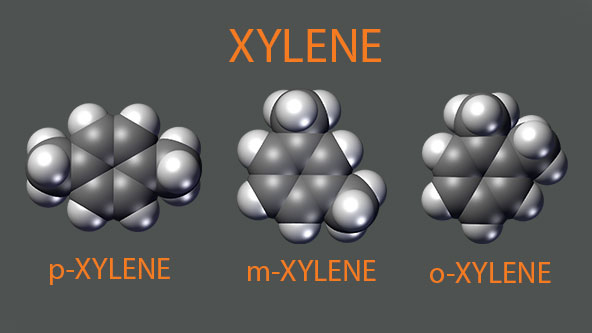What is Xylene?
Xylene is a colorless liquid chemical with a somewhat greasy consistency. This chemical is present in small quantities in gasoline and other fuels, comprising approximately 0.5-1% of crude oil. Millions of tons of xylene are produced each year, as the chemical is used as a solvent in the printing, leather, and rubber industries. It is also used for:
- Paint thinning
- Cleaning metal and circuitry
- The production of ink and adhesives
- Ear wax removal products
- Cooling baths for laboratory use
One of xylene’s major safety hazard is its flammability. As a result, it is important to use appropriate precautions when handling this chemical in the workplace.
OSHA has established a permissible exposure limit (PEL) for xylene of 100 parts per million (ppm), measured as an 8-hour time-weighted average (TWA). Employers must conduct air monitoring to determine if any employees are exposed to concentrations at or above the PEL, and take measures to reduce exposure levels, if so. In some cases, it may be necessary to select appropriate National Institute of Occupational Safety and Health (NIOSH) approved respirators, but keep in mind that personal protective equipment (PPE) like respirators should always be a last resort. Also, if you do determine that respirators are necessary, you’ll need to develop and implement a written respiratory protection plan.Potential Xylene Health Hazards
In case of contact with the skin or eyes, xylene can lead to redness and irritation. If ingested, this chemical may cause moderate gastrointestinal upset, including abdominal pain, nausea, and vomiting. Acute inhalation of the vapors can affect the central nervous system, causing headache, weakness, dizziness, loss of coordination, and difficulty breathing.
Be sure to take adequate precautions to protect yourself from these possible hazards while handling xylene. In order to prevent accidental exposure to this potentially dangerous chemical, we recommend that you wear the following:
- Splash goggles
- Lab coat
- Vapor respirator
- Gloves
In the event of a spill, use self-contained breathing equipment to avoid inhaling xylene vapors. Always wash your hands thoroughly after handling xylene or any hazardous chemical and ensure quick access to eyewash stations in the workplace.
First Aid for Xylene Exposure
In the event of accidental exposure to xylene, seek immediate medical attention and follow these first aid guidelines:
- Eye Contact: Remove contact lenses, if present. Flush eyes with plenty of water for 15 minutes or more.
- Skin Contact: Flush skin with water. Use an emollient on any irritated skin and wash contaminated clothing before reuse.
- Ingestion: Do NOT induce vomiting. Never give anything by mouth to an unconscious person. Loosen tight clothing and seek immediate medical help.
- Inhalation: Loosen tight clothing and seek fresh air immediately. If breathing is difficult, administer oxygen. If breathing is absent, perform mouth-to-mouth resuscitation and get medical aid.
Storage & Disposal of Xylene
Because xylene is extremely flammable, keep it stored in a segregated, approved area away from heat, spark, and sources of ignition. Keep away from incompatible materials, including oxidizing agents and acids. Ensure that the container is kept tightly closed and sealed until ready for use. Xylene, like any chemical, must be disposed of in accordance with local, state, and federal environmental regulations.
Need to track down the document? Visit our SDS/MSDS search tool. Get access to the industry-leading database of MSDS/SDS documents by signing up for a free trial.
If you need help managing your SDS library or your chemical inventory, our Chemical Management software will give you the support you need. You and your entire workforce will have unobstructed 24/7 access to your entire SDS library from anywhere, anytime. Our chemical ingredient indexing capabilities also provide visibility into your inventory at the ingredient level, cross-reference the ingredients against numerous regulatory lists, and summarize key information about regulatory radar screens and established occupational exposure limits (OELs).
Contact us today to request a demo so you can see for yourself how our Chemical Management software can help you meet regulatory requirements, including the updated HazCom Standard, and keep your entire workforce safe.
